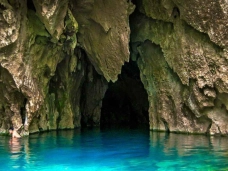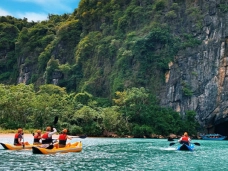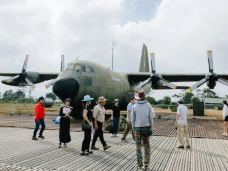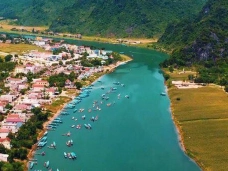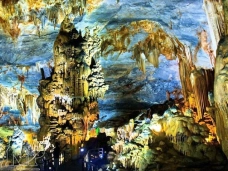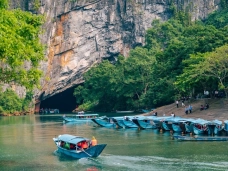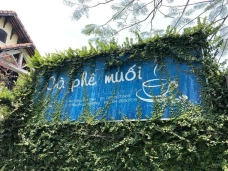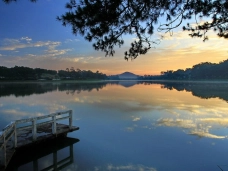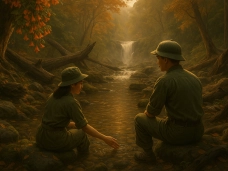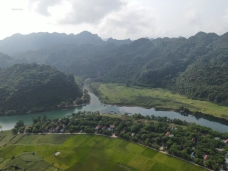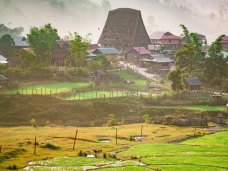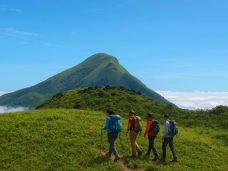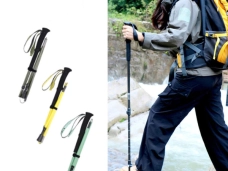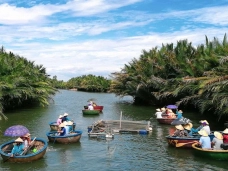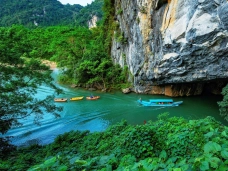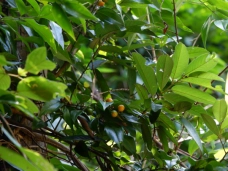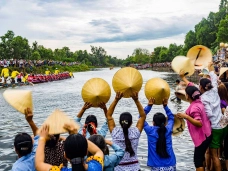The Ancient Well System of the Cham People in Quang Tri
03-09-2025 15:56
Main contents
- 1. A Subterranean Water Atlas Under Basalt Slopes
- 2. A System of Wells
- 3. Hydroponic Landscape: Watercress and 'The Finicky Green'
- 4. Layers of Engineering—From 'Complex' to 'Open' Wells
- 5. Why Are the Wells Located So Precisely?
- 6. “The 'Ancient Well Map' Extends to Trieu Phong, Cam Lo
- 7. Conserving a Living Water Heritage
- 8. A Different Feeling
- 9. Suggestions for an Immersive Experience
- 10. In Lieu of a Conclusion
My trip to Gio An last October (2024) left a profound impression of the area's natural grandeur and cultural depth. The route into the northwestern midlands of Quang Tri unfolds across slopes of ruddy basalt, strewn with spherical stones that stack like organic staircases. On either side, rubber trees stretch, occasionally interspersed with verdant tea gardens or fields of taro. Drawing closer to the ancient Gio An wells, the unmistakable murmur of water announced their presence before I could even see them; this was my initial realization that I had reached the "ancient well country"—a place where the Cham people of old communicated with subterranean currents through the silent eloquence of rock formations, topography, and sheer perseverance. Instead of digging conventional upright wells, they 'unveiled' them by precisely identifying springs at the base of the hills, constructing stone rims, settling ponds, and conduits, ensuring the water flowed gently, coolly, and purely throughout the seasons. This distinct approach evoked in me the sensation of exploring a vibrant, 'outdoor hydraulic museum,' rather than simply observing a relic paused in history.
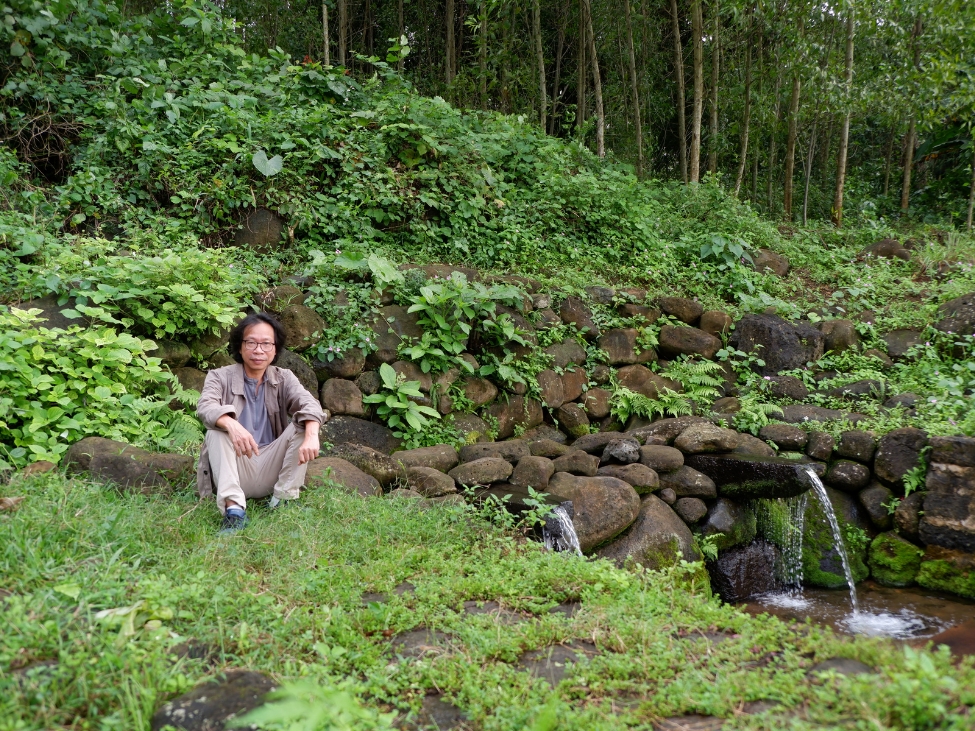 By the Ancient Gio An Wells
By the Ancient Gio An Wells
A Subterranean Water Atlas Under Basalt Slopes
Navigating Gio An, I perceived myself as walking upon a living atlas of subterranean and surface waters: pellucid streamlets, meticulously interlocking laterite embankments, settling pools—some perfectly round, others square or crescent-shaped—and narrow conduits, delicate as calligraphic strokes, precisely dimensioned for the water's flow. The foundational engineering here is deceptively simple yet profoundly wise: a primary ring to trap sediment, a secondary basin for purification, and a final channel to direct the water to the fields. The midland topography—where aquifers naturally surface at the base of the hills—provided the essential context for the Cham civilization to 'tame' this vital resource through meticulous stone construction, eschewing deep drilling or excavation. This remarkable indigenous wisdom forged a system of wells, clarifying basins, and distribution channels that stands as a rarity within Vietnam's rich hydraulic heritage.
The water here is cool in summer, warm in winter—a poetic description that is, in fact, literally accurate: contemporary accounts affirm that this water source 'has never ceased its flow,' even amidst the often-parched, earth-cracking dryness characteristic of Central Vietnam's climate. I knelt, dipping my hand into the surface, and palpably sensed the soothing coolness that seemed to thread through my fingertips, along with the distinctive, 'pristine' aroma of groundwater newly filtered through the laterite basin.
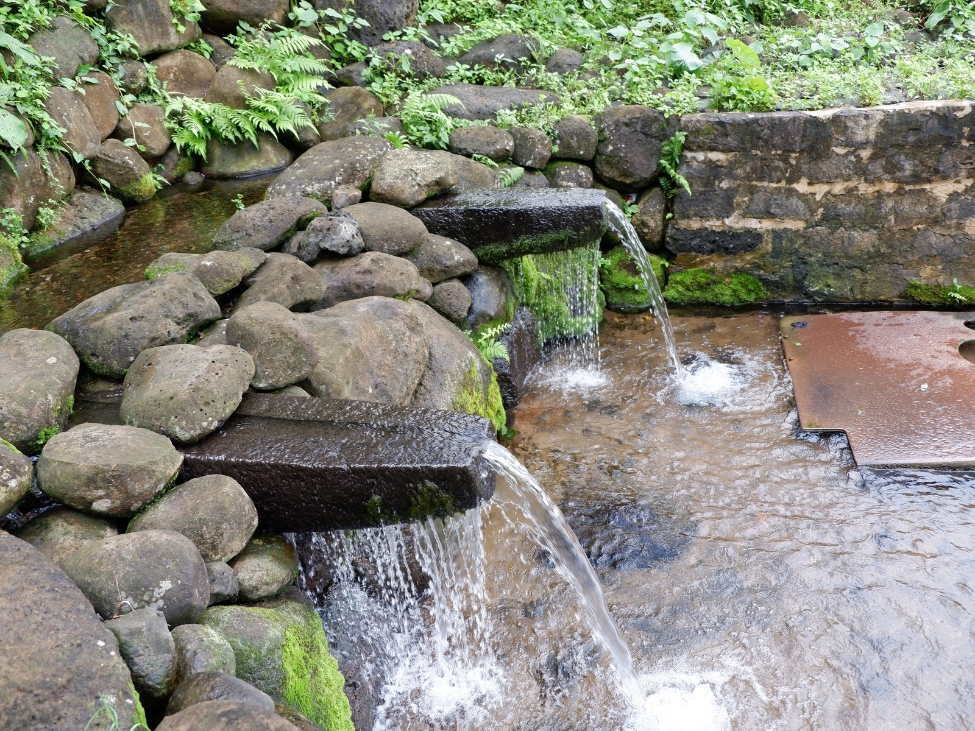 Gio An Ancient Wells
Gio An Ancient Wells
A System of Wells
The ancient Gio An well system comprises 14 wells scattered across five hamlets: An Nha, An Huong, Hao Son, Long Son, and Tan Van. The names of the wells are simple and endearing: Coi, Duoi, Bung, Trang, Dao (in An Nha); Gai 1, Gai 2, Nay (in An Huong); Tep, Ong, Ba, Gai (in Hao Son); Mang (Long Son); and Pheo (in Tan Van). Each name is a clue to its function or a story connected to the community: some wells are for bathing, some for drawing water, some exclusively for irrigation, and others are tied to local village customs. Standing before the "Ong Well" stone marker, I could picture the former segregation of bathing areas for men and women; a hint of ancient shyness mingled with the modern sounds of children at play.
Regarding their age, local documents and specialized cultural and tourism publications confirm that this well system is estimated to have been formed about 1,800 years ago (some sources suggest an even earlier date, linking it to the late Neolithic period). While there is still some academic variance, the consensus is that this is a very old and unique structure, both in its technique and its landscape. In 2001, the well system was recognized as a National Historical-Cultural Site. In 2019, Quang Tri province proposed its inclusion in the list of Special National Relics—a step that demonstrates a growing awareness of its conservation importance.
 The water from the well system is directed to the watercress fields
The water from the well system is directed to the watercress fields
Hydroponic Landscape: Watercress and 'The Finicky Green'
Nowhere is the unique "well-agriculture" connection more evident than in Gio An. The ancient well water nourishes an entire bed of watercress (which locals also call "rau liet")—a notoriously "finicky" plant when it comes to its water source. The water must be clear, cool, and have just the right flow; if it becomes murky or polluted, the greens will wilt and turn yellow. In season (from late autumn to late spring), the lush green fields of watercress fan out, with the stone embankments forming graceful, winding borders. Children run and play here as if in a natural aquatic park. The watercress, the wells, and the people form a single cultural ecosystem: a "legacy of ancient hydroponics" that is both functional and beautiful.
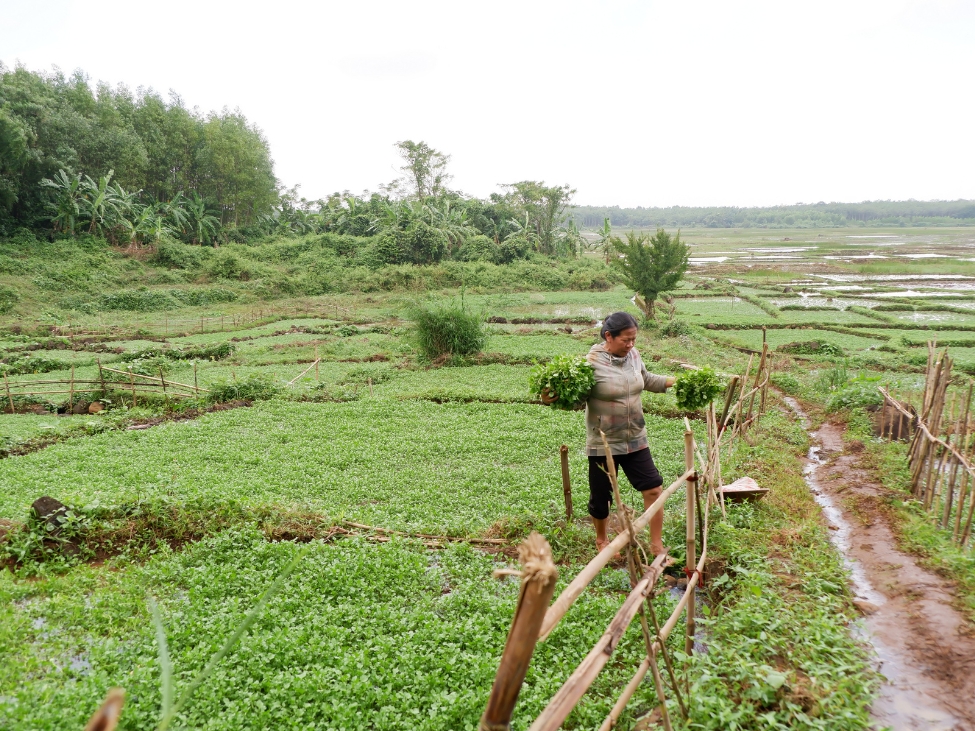 The farmer harvests watercress.
The farmer harvests watercress.
Layers of Engineering—From 'Complex' to 'Open' Wells
What’s fascinating about visiting the wells one by one is realizing the varying levels of architectural complexity:
- The complex group, such as Dao, Trang, Mang, and Gai wells, typically includes a complete system of settling pools, channels, storage basins, and small dams. Walking along the stone banks, I saw how a stream was divided, with some sections narrowed by a row of round stones, while others opened up into charming bathing pools.
- The simple group, like Ông and Bà wells, focuses more on daily life with basic bathing pools, drawing basins, and short channels. One late afternoon, I saw several farmers scooping water to wash their hands and feet, while kids jumped gleefully into the well basin; the habit of daily life tied to the wells remains, as natural as a breath.
- The 'open' wells at the foot of the hills: a style that 'welcomes' an exposed spring, excavated shallowly and reinforced with rounded stone pillars. The spring water is pushed up by the principle of communicating vessels, without the need for deep drilling. Seeing the water's surface lightly ripple in the shade of a tree, I understood why people call these wells "water eyes."
Why Are the Wells Located So Precisely?
Gio An is situated on a strip of midland red basalt, where spring water often surfaces or collects at the foot of the hills. This geological and topographical condition explains why the Cham people didn't dig vertically, but rather reinforced, opened, and channeled the water according to the natural lay of the land. Standing on Hao Son and looking down, I saw dark brown laterite steps embracing the clear water, with patches of green watercress connecting with patches of trees. It's a type of geomorphological aesthetics made so clearly visible by the ancient well architecture.
The choice of location is so precise that you get the feeling the ancient masters could hear the voice of the underground streams. Where the flow was strong, they created a settling pool; where a stream needed to be divided, they placed a channel; and where villagers needed to wash, they widened the well basin. The terrain-based engineering here isn't ostentatious, but it is both subtle and restrained.
 The Ông Well - Traditionally Used for Men's Bathing
The Ông Well - Traditionally Used for Men's Bathing
“The 'Ancient Well Map' Extends to Trieu Phong, Cam Lo
While Gio An is the 'capital' of the well-and-channel system, places like Trieu Phong and Cam Lo also preserve ancient village wells tied to feng shui and daily life. In Luong Kim hamlet (Trieu Phuoc), the Tay well is cherished by villagers as the community's spiritual anchor. Meanwhile, Mai Loc (Cam Lo) has smaller-scale wells like Cay Thi and Ong Cay, which also use the traditional method of stone embankments and spring tapping. The character of the wells in these areas is geared more toward water collection and community gathering, rather than creating complex canal systems like in Gio An—but their shared philosophy remains to follow the underground streams, viewing water as the soul of the village. (Compiled from official government and local media reports; for printed publications, you can cite additional sources from the Provincial People's Committee/Center for Information and Communication regarding the list of ancient wells in traditional craft villages).
Conserving a Living Water Heritage
The ancient Gio An wells hold more than just archaeological and technical value; from a management perspective, this is a living water heritage. Quang Tri province has designated the site as a National Relic (in 2001) and proposed its upgrade to a Special National Relic (in 2019). Simultaneously, it has planned a protective zone spanning over 3.7 hectares, which includes the 14 wells, their underground water sources, and the surrounding landscape—an approach that directly addresses the "relic ecosystem" rather than just preserving the physical architecture. Alongside this is a move toward community-based tourism: creating small parking areas, walking paths, and clean agricultural products, allowing the heritage to sustain itself through tangible benefits for the local population.
I met a woman selling vegetables at the edge of the Mang well. She told me, "Here, the vegetables must be clean, because the water is clean; as long as the wells remain, the vegetables remain, and the village remains." Her words were as simple as the earth, yet they captured the best conservation philosophy: preserving the wells is not just out of nostalgia, but because they are the water infrastructure for a sustainable way of life.
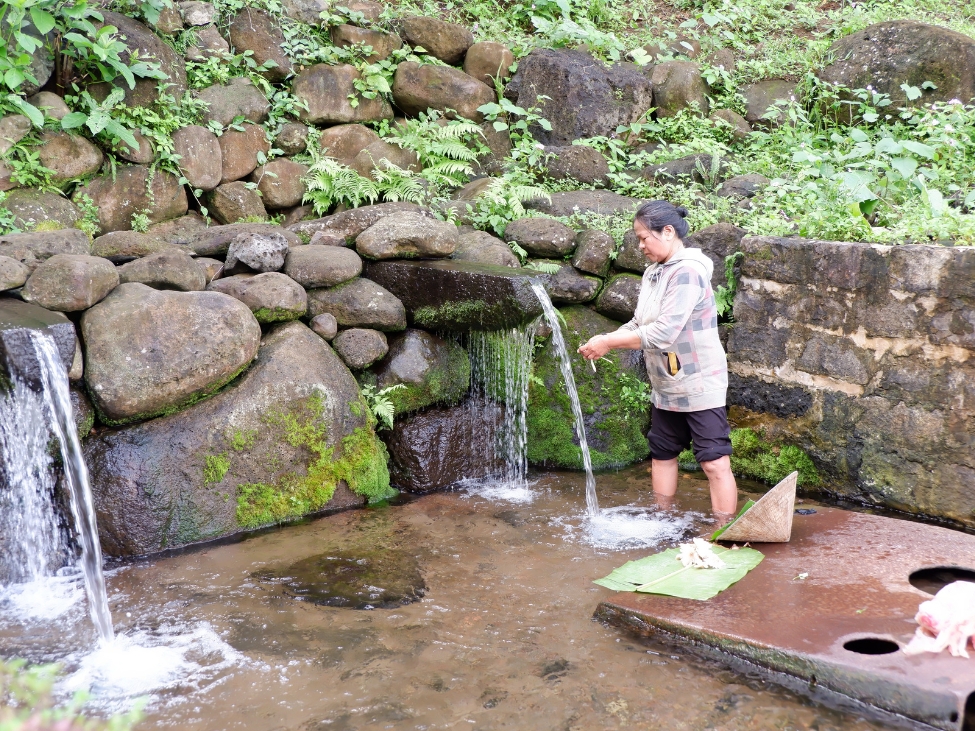 Utilizing the water from the ancient wells
Utilizing the water from the ancient wells
A Different Feeling
Having traveled through many parts of Central Vietnam, I have seen ancient wells in heritage cities like Hoi An, and traditional village wells in Binh Dinh and Ninh Thuan. But Gio An gave me a completely different feeling: the wells here are a systemic irrigation infrastructure, intimately linked to agriculture and the geomorphology of the basalt hills. In the ancient towns, wells typically served daily life within the urban architectural space; in Gio An, the wells "go with" the vegetable fields, stone embankments, and water channels, creating a water matrix that is fluidly organized by the terrain. This environment makes the experience both rustic and technical, as if one is walking through an outdoor laboratory on Cham water engineering.
The people of Gio An recount—by oral tradition—the story of a Cham princess who, walking through a parched land, struck her staff on the ground and caused a spring to burst forth; or the tale of the Ong and Ba wells, tied to the couple who founded the water village, after whose passing the villagers built the wells in their memory. These legends may not be found in academic records, but they speak to a single truth: the wells are sacred gifts, a place where residents express gratitude to their ancestors and to the 'water deity.' This belief explains why no one dares to fill in a well, and why the acts of dredging and maintenance are preserved as an everyday ritual across generations. (This part is based on local folklore; for official publications, you should clearly note it as 'according to local oral tradition'.)
Suggestions for an Immersive Experience
If you wish to "hear" the wells tell their stories, you must move at a slow pace:
- Morning: Walk through Hao Son, An Nha, and An Huong. When the sun is still low, the laterite stone absorbs less heat, and the water is as clear as a mirror. Standing at the Trang well, watching the curving channels pour water into the fields, you will see the subtlety of the flow control—just enough to avoid eroding the banks.
- Noon: Visit Ong or Ba well. Sitting on a mossy stone slab, listening to the children splashing water, you will understand why this place is not just a relic but also a water playground for the whole region during record-hot seasons.
- Afternoon: Enjoy a bowl of watercress salad with garlic and chili, or dip the greens in fermented fish sauce, then stroll past the Mang well as the sun begins to set. The laterite stone turns a beautiful honey-brown, perfect for photos.
One small thing I learned here: don't crowd the water, don't litter, and don't step on the vegetables. The wells thrive on the community's gentle discipline—visitors only need to 'when in Rome,' and everything will flow as smoothly as the water itself.
Begin your Ancient Wells Memory journey by registering here.
In Lieu of a Conclusion
Because in an age of modern irrigation and water supply projects, the ancient Gio An well system offers us a lesson in water-based moderation: using local terrain and indigenous materials to achieve a sufficient, long-term goal. Because in the context of climate change, a sustainable water source is more crucial than ever—and here, we see a model of community water management that has been operating for hundreds, if not thousands, of years. Because tourism is not just about looking, taking photos, and leaving; community-based tourism can become a pillar for conservation when the benefits for the locals are directly tied to keeping the wells clean and the springs pure. Quang Tri's decision to zone a protected area of over 3.7 hectares and develop small-scale services connected to the relic is a sound bet on this water heritage.
I left Gio An carrying a few bunches of watercress and some termite mushrooms that a woman gave me when I happened to meet her at a well. The round laterite stones still bore my wet footprints. The water continued to flow calmly through the settling basins, snaked through the stone channels, and watered a newly planted bed of greens. Suddenly, the idea of a "living relic" came to my mind: there are some heritage sites we merely stand and look at, and there are others we live alongside. The ancient Gio An wells belong to the latter group. They don't just tell the story of the Cham, the Vietnamese, and the Quang Tri people; they tell a story of how a community organized its water to survive and thrive.
Somewhere, a "princess" in folk imagination still gently taps her staff on the ground, calling forth a new spring. As for us, the generations that follow, we only need to know how to bend down and drink with respect, so that the millennium-old flow can continue to have a place to run.
Tuệ Minh
Comments
Comments (Total 1)
Tanaka
04-09-2025
Related Articles
13-12-2025
Giải mã tên gọi Phong Nha – Kẻ Bàng
26-11-2025
Khe Sanh – A Journey into Memory
05-11-2025
8 Unmissable Instagram Spots in Da Lat
28-10-2025



